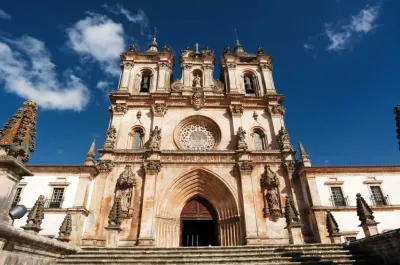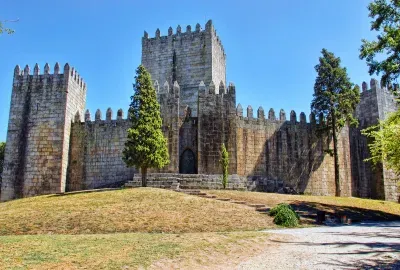
Portugal's Official Top 7 Things to See
The Seven Wonders of Portugal (Sete Maravilhas de Portugal) is a list of the finest national monuments and cultural highlights in the country. It was supported by the Ministry of Culture and involved a panel of experts choosing from an initial list nearly 800 candidate monuments. Once they had whittled down the candidates to a mere 21 it was left to the Portuguese public to vote on the very best of the best. In short this is the official bucket list of what to see in Portugal.
Conducted in 2006 the competition was part of the global "New Seven Wonders of the World" contest. Although none of Portugal's national monuments made it into the world finals these are still spectacular cultural icons and a must see for anyone visiting Portugal.
I have to admit I don't know if the list is in any specific order - I tend to think not as all of these cultural wonders are equally stunning in their own ways.
-
7. Belem Tower

Torre de Belem - Sunset The Torre de Belem was built in 1515 to guard the entrance to Lisbon's busy harbour. But the designer (Francisco de Arruda) went far beyond the requirements of a functional fortress and created a Manueline masterpiece decorated with innumerable exquisite decorative flourishes. The stonework features beautiful ornate windows and Moorish inspired turrets along with motifs and sculptures of things as diverse as historical figures and a rhinoceros.
The tower went well beyond its role as protector of the harbour and became something of a national symbol. This is where many of the Voyages of Discovery departed and has long been a welcoming site for returning sailors. Today the Tower of Belem is listed as a UNESCO World Heritage monument.
-
6. Pena Palace

Pena Palace The real-life fairy-tale castle that is the Palace of Pena sits high above Sintra atop São Pedro de Penaferrim. If ever the word 'eclectic' was used to describe a mix of architectural styles then it was for this fantastic palace. There are Moorish domes and arches, medieval towers, Gothic flourishes and, of course, Manueline windows. All these styles are pulled together in a mix of colours to create what is regarded as one of the finest examples of Romantic architecture to be found anywhere.
It was Prince Ferdinand of Saxe-Coburg-Gotha, husband of Queen Maria II, who chose the site and had the vision (and unlimited means) to build the Pena Palace. It was to serve as a summer home for the Portuguese royal family and did so until 1910 when the Revolution forced the royal family to flee the country. For many years the palace fell into disrepair. However, after many years of restoration it has been returned to its former glory and is classified as a UNESCO World Heritage site.
-
5. Jerónimos Monastery

Jerónimos Monastery Along with the Tower of Belem, the Jerónimos Monastery is the most visited historic site in Lisbon. It is hard to quite convey the size and opulence of this magnificent building in words alone. Stretching for nearly 300 metres along the Belem riverfront the monastery is literally covered in Manueline detailing. Dating back to the beginning of the 16th century there is little doubt this is the finest example of Manueline architecture anywhere.
Unsurprisingly the building of the monastery took nearly a century and the cost was staggering. Paid for by the fortunes amassed during the Age of Discoveries it was vanity projects such as this that almost ruined the nation by the 18th century.
The interior of the monastery features a number of exquisitely detailed cloisters and the main chapel - the Church of St Mary of Belem. This cathedral-like church with its high, vaulted ceiling is as lavishly decorated as you would imagine. It also holds the tombs of some of Portuguese history's heavyweights such as Vasco da Gama, Luís Vaz Camões, Alexandre Herculano and Fernando Pessoa.
-
4. Alcobaça Monastery

Alcobaca Monastery The monastery of Alcobaça is Portugal's largest church and is something of a contrast to the flamboyant Jeronimos Monastery in Belem. Rather simple and austere in comparison this vast Gothic church is equally impressive in its own way.
Dating back 900 years the monastery was founded by Portugal's first king, D. Afonso Henriques who donated the lands in Alcobaça to Cistercian monks following the reconquest of the region from the Moors. Work on the main church, with its towering central nave was completed in 1223. Additional features were added to the monastery over the centuries by subsequent kings including the exquisite Cloister of Silence ordered by King D. Dinis in 1308. The facade of the monastery was completely remodeled in the Baroque style during the 18th century with graceful marble statues of São Bento and São Bernardo flanking the great doorway - which is the only remaining original feature.
One of the highlights of the Alcobaça Monastery are the tombs of King Pedro I and his murdered mistress Inês de Castro. The beautifully carved stone coffins lie opposite each other in the Central Nave with feet facing so that come Judgement Day, when they re-awake, the first thing they would each see was their beloved.
-
3. Batalha Monastery

Capelas Imperfeitas (Unfinished Chapels) The Batalha Monastery, or Mosteiro de Santa Maria de Vitória, to give it its full name, was built to commemorate the 1385 Battle of Aljubarrota in which the Portuguese forces triumphed over the Castilians. With seemingly limitless funds the resulting abbey is both massive and magnificent.
A mixture of Gothic and Manueline styles, the monastery was constructed over two centuries with successive monarchs leaving their mark. It was under the reign of King Joao I that master builder Afonso Domingues began work, followed by Catalan architect Master Huget. They were responsible for the main Gothic structure, with Huget's most notable contribution being the star-vaulted ceiling of the chapterhouse.
As wealth began to flow into Portugal from the Discoveries further funds were channeled to Batalha. In the 15th century the monastery became a royal pantheon under King Duarte and the elaborate Manueline became the dominant styling. Wonderful examples of this can be seen in the tracery of the cloister arches and the stunning octagonal Unfinished Chapels.
With the dissolution of the monasteries in 1834 the Mosteiro da Batalha became a national monument under state control. Today the monastery houses the Tomb of the Unknown Soldiers and is in essence a museum and showpiece of medieval architecture.
-
2. Castle of Óbidos

Obidos Castle Of all Portugal's 7 Wonders, it is the Castle of Óbidos that I think is least deserving to be on the list. However, if you take the entire town, which is surrounded by medieval walls, then it is definitely worth a visit. Óbidos is a jumble of whitewashed houses with terracotta roofs, cobbled alleyways and, of course, an enormous 13th century castle.
The Castelo de Óbidos we see today was largely constructed by King D. Dinis, however there has been some form of castle on this hilltop since the Moors occupied this part of Portugal in the 8th century. It is an impressive building and still has an air of impregnability about it. Within the walls is the Palace of the Alcaldes, a substantial whitewashed building most notable for its fine Manueline windows. In 1950 the castle was converted into a luxury hotel, the Pousada Castelo de Óbidos.
Other features of Obidos' defences include the Porta de Vila - the main gateway into the town with its beautiful azulejos, and the town walls. These extend for over a kilometre around the perimeter of the town and can be walked along. However, it is worth noting there are no handrails and the drops are quite large in places.
-
1. Castle of Guimarães

Guimarães Castle Guimarães is oft referred to as the birthplace of Portugal. It was certainly the birthplace of the first king, Afonso Henrique, and he chose it to be the capital. In fact it is said that Afonso was born within the walls of the castle and baptised here. The font that was reputedly used is kept in the tiny Romanesque chapel of Sao Miguel which sits in the castle's western end.
Steeped in such history, Guimarães Castle is also one of the finest castles in Portugal. Built on a hill overlooking the town, the original 10th century castle was intended as a place of refuge for the monastery and townsfolk who lived under constant fear of attack from both the Normans and the Moors. In following centuries the castle was much remodeled and enlarged, much of the work at the behest of King Dinis during the 13th and 14th centuries. In its day the castle must have been an imposing structure; with 7 rectangular towers laid out in a shield shape with huge crenellated walls between it dominates the skyline.
As you would imagine cutting it down to a list of just 7 national monuments was something of a challenge and we thought it was worth mentioning the other finalists.